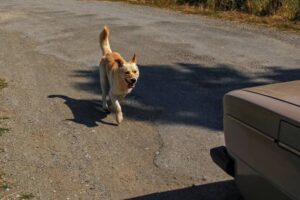Why Dogs Run Behind Your Car: What It Really Means
- Blog

You’re driving through your neighborhood or a quiet street, and suddenly—a dog starts chasing your car. It might bark, growl, or sprint right behind your tires. If you’ve experienced this, you’re not alone. It’s one of the most common complaints drivers have, especially in areas with a high population of stray dogs.
So, why do dogs chase cars? Is it aggression? Fear? Instinct? Let’s explore the real reasons behind this behavior and how to handle it safely and compassionately.
1. It’s Not Personal – It’s Instinct
Dogs are natural predators. Movement triggers their prey drive—a deeply ingrained instinct passed down from their wild ancestors. When a car zooms past, a dog’s brain can interpret it as something to chase. This reaction is especially strong in breeds or street dogs with high energy or territorial behavior.
2. Territorial Behavior: You’re In Their Space
Dogs are territorial animals. If a car enters what they perceive as their space—especially near their food source, sleeping area, or a familiar lane—they may bark or chase to protect their turf.
This is particularly common among stray or community dogs in India who have established their own zones on the street.
Dogs don’t understand that your car isn’t a threat—it’s just fast, loud, and unfamiliar. That’s enough to trigger a defensive response.
3. Fear and Anxiety Around Moving Vehicles
Not every car chase is aggressive. For some dogs, it’s driven by fear. Loud engine sounds, vibrations, or headlights can startle a dog. In their panic, they may run after the car as a reactive, confused behavior.
This is why puppies or previously abused strays might show heightened reactions to vehicles.
4. Boredom or Lack of Stimulation
Dogs, especially street dogs, don’t have toys, people, or much stimulation in their lives. A moving car provides sudden excitement. Chasing it gives them something to do—an outlet for their energy.
For a bored dog, a speeding car is like a game: fast, unpredictable, and worth chasing.
5. Learned Behavior from Other Dogs
Dogs are social learners. If one dog in a group chases a car, others will often follow. It becomes a pack behavior—even if some don’t fully understand why they’re doing it.
This is why you often see multiple dogs running behind the same vehicle, especially in rural or semi-urban Indian neighborhoods.
6. Certain Car Sounds Can Agitate Dogs
Some car engines, especially louder or older ones, may emit frequencies or vibrations that dogs find irritating or threatening. Since dogs can hear a wider range of frequencies than humans, they might react to sounds we don’t even notice.
7. How to Stop or Avoid Dogs Chasing Your Car
While it’s a natural behavior, car-chasing can be dangerous for both the dog and the driver. Here are a few tips:
- Slow down when driving through dog-prone zones.
- Avoid honking or revving your engine. Sudden noises escalate their reaction.
- Do not engage—don’t yell, throw things, or try to scare the dog. It reinforces their behavior.
- Talk to local animal welfare groups. In India, organizations like K9 Safe Animal help manage street dog behavior through vaccination, training, and feeding programs.
8. Can This Behavior Be Trained Out?
Yes—especially in pet dogs or community dogs that are fed and managed by residents. With consistent, positive training, dogs can be taught not to chase moving objects, including cars and bikes.
However, for street dogs, it’s more challenging unless there’s a community effort to monitor and manage the behavior through:
- Feeding schedules
- Sterilization
- Positive reinforcement
- Training or relocation (in extreme cases)
Final Thoughts
Dogs chasing cars may seem like an annoyance, but it’s usually a sign of fear, instinct, or boredom—not malice. Understanding the reasons behind this behavior helps us respond with empathy instead of frustration.
Instead of speeding up or yelling at street dogs, consider supporting animal welfare groups that help address the root cause of these behaviors.
Want to Help Street Dogs in India? Visit K9SafeAnimal.org
Organizations like K9 Safe Animal work across India to:
- Rescue injured or distressed strays
- Manage community dogs through feeding and sterilization
- Provide medical aid and shelter
- Offer training and adoption services